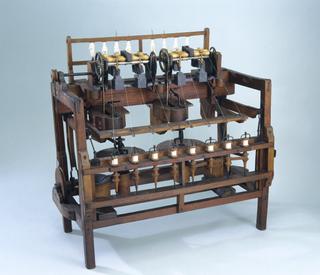
Machine used for covering wires with silk and cotton, 1837
- Made:
- 1837 in Whitechapel
- maker:
- William Thomas Henley








Machine used for covering wires with silk and cotton for electrical purposes, made by W T Henley, Whitechapel, London, England, 1837
Machine used for covering wires with silk and cotton for electrical purposes, made by W T Henley, Whitechapel, England, 1837.
This machine was made by W T Henley in 1837, in order to cover wires in silk or cotton thread for electrical purposes. This may be Henley’s original experimental model. Similar machines were supplied to workers at home who made up the wire on piecework rates. This machine was key to Henley's early success: copper or iron wire could be easily purchased, but getting it covered was an expensive process, a deterrent for anyone experimenting with electromagnetism. Henley could cover six wires at a time with this machine, and could therefore make enough wire not only for his own purposes, but also to sell to a large group of customers. Henley found that he could make £1 a day selling his wires, and by 1839, his wire supplies were about half the price of any other sellers.
Details
- Category:
- Textiles Machinery
- Object Number:
- 1939-139
- Materials:
- wood, steel, silk, cotton (fibre) and metal (unknown)
- Measurements:
-
overall: 1040 mm x 870 mm x 670 mm, 88 kg
- type:
- winding machine
- credit:
- Donated by W.T. Henley's Telegraph Works Company Limited




